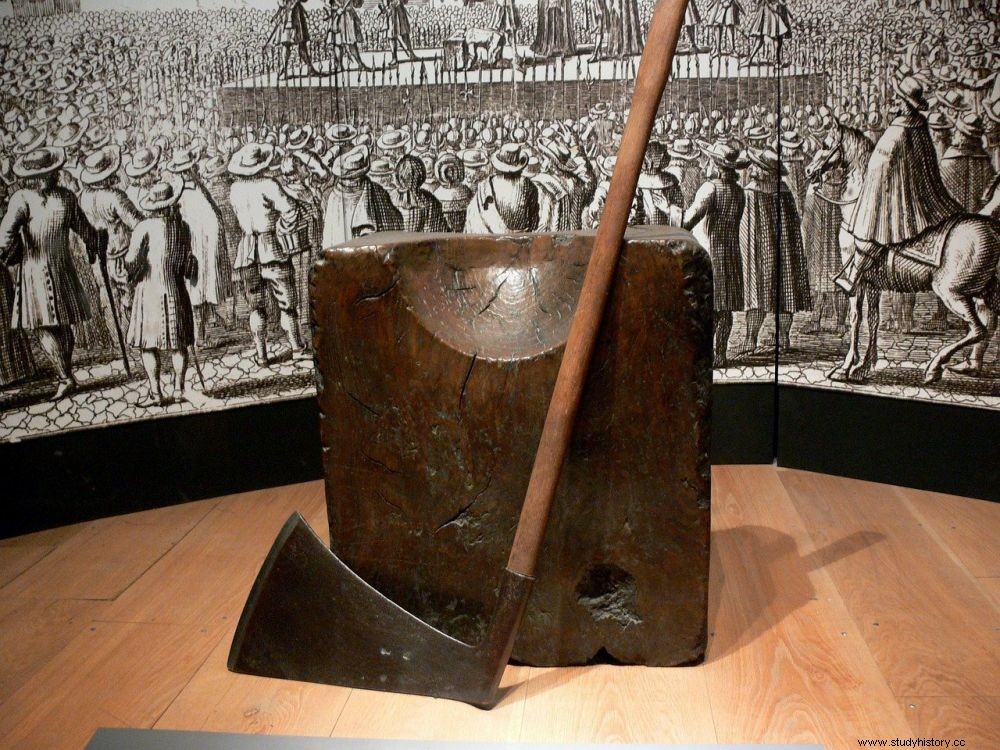How was the profession of executioner born? Who performed this task before? Science and the Future posed these questions to the historian and jurist, Frédéric Armand.

Executioner's ax on display at the Tower of London, England.
This article is from the magazine Sciences et Avenir Hors-série n°194 "Crimes et Châtiments" dated July-August 2018.
Who carried out death sentences before the appearance of the executioner at the beginning of the 14th century?
Frederic Armand: Under the Merovingians and the Carolingians, dukes and counts were responsible for dispensing justice on their lands. When they condemned an individual to the death penalty, they could carry out the sentence themselves. Or delegate this task to a subordinate, or even to a vassal as a chore. Corporations were also solicited, such as that of butchers or millers. However, until the 14th century, capital punishment was rarely imposed, unlike pecuniary fines and banishment.
In what context - historical, social - does this function emerge?
The first executioners mentioned in the writings did not yet have the exclusive function of executing the condemned. They often take on other responsibilities such as cleaning markets, roads, hunting stray dogs... righteousness" - which freezes the criminal procedure. All disparate practices are brought together in a written code that formalizes the administration of justice and a scale of penalties. He attributes the execution of the death sentence to the executioner exclusively.
Who carried out death sentences before the appearance of the executioner at the beginning of the 14th century?
Frederic Armand: Under the Merovingians and the Carolingians, dukes and counts were responsible for dispensing justice on their lands. When they condemned an individual to the death penalty, they could carry out the sentence themselves. Or delegate this task to a subordinate, or even to a vassal as a chore. Corporations were also solicited, such as that of butchers or millers. However, until 14 th century, the death penalty was rarely imposed, unlike the pecuniary fine and banishment.
In what context - historical, social - does this function emerge?
The first executioners mentioned in the writings did not yet have the exclusive function of executing the condemned. They often take on other responsibilities such as cleaning markets, roads, hunting stray dogs... righteousness" - which freezes the criminal procedure. All disparate practices are brought together in a written code that formalizes the administration of justice and a scale of penalties. He attributes the execution of the death sentence to the executioner exclusively.
What were the qualities required for such a position?
First and foremost blind obedience was demanded of the executioner. We expected him to follow orders without trying to improvise. And his alcohol consumption had to remain reasonable. For the rest, the office was open to all… but the applicants were few. This is why we very quickly saw the appearance of families of executioners. From an early age, the son helped the father. He thus entered the profession already trained and competent.
What relationship do the French have today with this figure?
The image of the executioner, like the word, instantly refers to the Middle Ages. In other words, a distant and bygone era... when the death penalty was only abolished in 1981. Since the Revolution, however, capital punishment was imposed "in the name of the people". But the direct link of responsibility between the people and the condemned was distended from the moment the execution was concealed, from the end of the 19 e century.
In 1820, executions still took place on busy market days. Gradually, the authorities decided to hide the show by "moving" it to outlying neighborhoods and scheduling it before dawn. Moreover, the killing ceased to be announced in the press. However, in 1939, the last public execution, that of Eugène Weidmann, the "velvet-eyed killer", at the entrance to Versailles prison, attracted crowds... and journalists, who even filmed it .
This article is from the magazine Sciences et Avenir Hors-série n°194 "Crimes et Châtiments" dated July-August 2018.
